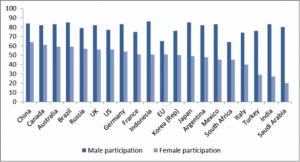Griffith Law School’s Associate Professor Susan Harris-Rimmerlooks at the implications from the recent Women 20 Summit in China and the potential for increased female labour participation
The Vice President of China Li Yuanchao opened the W20 Summit in Xi’an on 26 May 2016 alongside host All-China Women’s Federation. His words showed the increasing legitimacy and urgency of the gender and growth agenda, which the Chinese term ‘She-Power’.
It is all the more important to pool women’ s wisdom and strength at a time when the global economic recovery remains fragile. As the Chinese economy moves into a New Normal, efforts are made to encourage mass innovation and entrepreneurship and women are essential in this endeavour.
The G20 Summit in Brisbane 2014 made history by including a specific target to reduce the gender participation gap in formal labour markets in G20 economies by 25 per cent by 2025, whilst also outlining country strategies to achieve growth. This promise could bring more than 100 million women into the labour force, and yet, it garnered little media or civil society attention.
This goal could be seen as the first of the ‘concrete actions to overcome the barriers hindering women’s full economic and social participation’ called for in the Los Cabos Declaration in 2012. The Turkish Presidency followed by setting up the W20 engagement group to provide policy advice to leaders. China consolidated this process with the W20 Summit in Xi’an where the representatives of G20 countries and invited guests agreed a communiqué to be presented to the G20 leaders in the lead-up to the Hangzhou Summit.
W20 delegates underlined the importance of seeing demonstrable progress by the G20 Employment and Labor Ministers and the Employment Working Group. In debates during the Turkish Presidency, the members have opted for self-reporting against a template on a biennial basis. The ILO and OECD will compile a report on new policy initiatives, which may or may not be made public.
W20 delegates urged member states to update and publish their strategies towards the target, and adopt transparent and rigorous monitoring process with, if necessary, the technical support of international organisations to make the data more comparable and more accessible to the public.
2015 labour participation in G20 countries by gender

Sources: World Bank and International Labour Organization, Key Indicators of the Labour Market database, compiled by Hannah Wurf, Reconsidering the G20 Approach to Setting Targets, G20 Monitor, May 2016, available at http://www.lowyinstitute.org/publications/g20-monitor-new-considerations-chinas-2016-presidency
China has good female labour participation rates already, as the data indicates and the Vice-President underscored in his speech. However, women are often in low skilled jobs, are under-paid and suffer from many forms of discrimination and stereotyping, as is the case in most of the G20 nations. The issues for the host in this area are still manifold, with the lifting of the one-child policy, and accompanying childcare and aged care concerns. China may soon increase the retirement age of women to be equivalent to men. The passage of the domestic violence law this year also has positive implications for women entering the workforce.
China went one step further at the W20 by linking the female labour participation debates to their headline outcome of a G20 Blueprint for the Innovative Growth, to be released in Hangzhou. The Vice President noted with pride that 55% of e-commerce is conducted by women in China, and that the majority of online purchasing power is also female-dominated.
The focus on women in the digital economy by China has implications for the G20 Skills Agenda. The W20 recommended that the G20 Leaders should work to narrow and remove the digital divide, help women to gain equal access to the internet, provide effective digital skills training for women, set targets for women and girls to study STEM, and strengthen the capacity of women to undertake internet-based entrepreneurship and employment.
G20 members could take special measures to encourage inclusive sourcing policies by governments and by corporations, to include more women as suppliers in global value chains by establishing baseline data, setting targets and reporting on progress.
They could support women’s entrepreneurship and launch specific G20-wide programs to help women overcome business start-up barriers, grow and sustain their businesses, including through trade. Governments can improve women’s access to and credit and investor networks, training, information services and technical support. Governments can provide economic and trade incentives for businesses that are at least 51% owned, managed and controlled by one or more women. There are excellent precedents for these policies in Malaysia, the US and Israel.
Time is of the essence as the world moves into the Fourth Industrial Revolution. Just as some developing countries were able to ‘leap-frog’ developed nations in infrastructure terms; straight to mobiles with no need for laying cables; renewables without power stations. China went straight to DVDs without VHS. There must be the potential for increased female labour participation to move straight to decent quality work in the new skills economy, supported by adequate social protections.
G20 members are debating how best to recalibrate Gross Domestic Product to include activity in the digital economy. This presents an opportunity to systematically recognize and measure all forms of work and value, including creating a national income accounting system that includes unpaid care work.
The W20 called on the G20 leaders to consider 22 recommendations. Read the full W20 COMMUNIQUEand recommendations.
The next W20 Summit will be hosted by Germany in 2017 with the full support of Chancellor Merkel.
- Associate Professor Susan Harris-Rimmer is anAustralian Research Council Future Fellow and has been a board member of UN Women National Committee Australia and former president of the voluntary non-governmental organisation Australian Lawyers for Human Rights. She also often acts as a policy adviser to government and produces policy papers.
